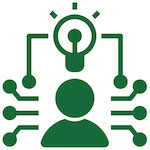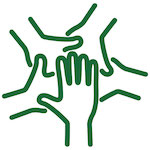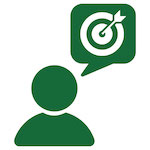Leveraging Technology
 Students who can leverage technology are able to use digital/technological tools and systems ethically, appropriately, and effectively to complete tasks and accomplish goals.
Students who can leverage technology are able to use digital/technological tools and systems ethically, appropriately, and effectively to complete tasks and accomplish goals.
What this could look like across a program, for a learner, and in a single course:
| When I am learning | When I am ready to work with others | When I am prepared for my career | |
|---|---|---|---|
| What competency development might look like across a program... |
When I am working on an individual task, I experiment with and consider a variety of tools before selecting one. I particularly consider the tool’s fit with my personal goals and intended audience. I pivot to different tools when I encounter technological challenges. |
I use technologies to collaborate with diverse teams in achieving common goals. I resolve challenges with technologies that limit agile and engaged collaboration. |
I create and/or adapt technological solutions to address real community problems. I deploy technology for and with communities that contribute to addressing inequities. |
| What this might look like for a student... | Max learns a variety of tools to generate the content and visuals for their presentation, including a spreadsheet that generates typical graphs used in the discipline. | Max uses the peer feedback tool in Canvas to suggest modifications to someone else’s presentation for their morning class. Then they update channels in a common communications app linking materials their group will use for their podcast. | Max helps a community group update their social media approach to reach more younger adults. Max also suggests modifications to the group’s webpage to improve the accessibility of their visuals. |
| What this might look like in a course... | Dr. Sarah Lee facilitates a collaborative project in her Applied Psychology II course, where students work in teams to develop a digital tool for peer support. To help students like Max develop competency in leveraging technology, Dr. Lee introduces various collaborative tools such as Canvas for peer feedback and communication apps for project management. She provides initial training sessions on how to use these tools effectively, emphasizing their role in enhancing team collaboration. Dr. Lee schedules regular check-ins to monitor progress, offers guidance on best practices for digital communication and teamwork, and encourages students to give and receive constructive feedback through the peer feedback tool. By providing structured opportunities for practice and ongoing support, Dr. Lee ensures that students can effectively use technology to collaborate and achieve common goals. | ||
Undergraduate Student Competency Program Rubric – utilize or adapt this rubric for programs and courses.
Other ideas for developing this competency in the classroom:
- Exploring New Technologies: Provide opportunities for students to explore and adopt new technologies through guided exercises, tutorials, and hands-on practice.
- Case Study: Provide a scenario where students must choose the appropriate software to solve a problem, such as selecting the best tool for data visualization.
- Discipline-Specific Technology: Integrate discipline-specific technology tools in coursework to familiarize students with their practical applications.
- Collaborative Technologies: Encourage the use of collaborative technologies, such as shared documents, project management software, and communication platforms, for group projects and assignments.
- Creating Technological Solutions: Design projects that require students to create or adapt technological solutions for real-world problems, emphasizing the ethical and effective use of technology.
- Community Partnerships: Partner with community organizations to develop projects where students use technology to address community needs, focusing on equity and accessibility.
- Portfolio Development: Encourage students to include their technology-based projects in their portfolios, showcasing their ability to leverage technology in diverse and impactful ways.
Support
The Gwenna Moss Centre for Teaching & Learning
- Connect with us to get one-to-one strategies to help learners develop this competency in your classroom. Email for information: gmctl@usask.ca
Career Services
- FUSION modules: Digital Literacy (AI), Problem Solving, Creativity & Innovation, Metacognition
University Library
- Learning with Technology Toolkit - Guide on effectively incorporating digital tools into teaching and learning to support technological literacy and competency.
- Understanding Generative AI - Resources explaining how AI can be used in academic settings, helping students understand and apply AI tools responsibly.
- Online Learning Readiness - Assessments and resources that prepare students for success in online learning environments, supporting technological fluency.
- Learning Hub - Instructors can find academic skills resources, tutorials, and other learning support services for students. These resources can be integrated into courses as appropriate to support the development of USask graduate competencies
- Instructors can request workshops and custom materials from learning specialist and librarians tailored to course needs to support the USask graduate competencies.





